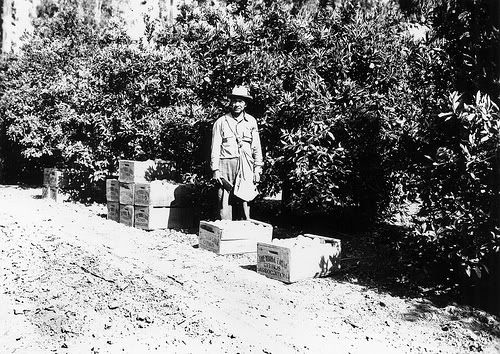The following is an excerpt from a work-in-progress called The Town I Live In.
The racial segregation in Fullerton, particularly between whites and Mexicans, did not spring up out of nowhere. It was a direct result of the citrus industry and the wealthy growers (like Charles Chapman) who needed cheap labor.
In a paper entitled "Mexican Villages in the Orange County Citrus Towns 1900-1950," UCI professor Gilbert G. Gonzalez sheds light on the roots of racial segregation in Fullerton, which was integrally tied to the orange industry.
Unlike other crops like corn and wheat, oranges must be harvested by hand. Gonzales writes, "Since the beginning of citriculture some 6,000 years ago no other method besides hand-picking as been developed to remove the orange from the tree."
Orange County, which was once comprised of thousands of acres of orange groves (owned mostly by a wealthy elite like Chapman) needed "to establish a local, permanent labor supply." Beginning around 1910, following Chinese and Japanese Exclusion Acts, this labor supply came primarily from Mexico.
Unlike immigrants from Eurpoe, Mexican immigrants were not welcomed into the society at large. Rather, "the labor policy of many local grower associations included the construction of housing for their picking labor, and this usually meant housing for Mexican families...citrus picking came to be associated with the Mexican communities as if its inhabitants were bound to a single function in the economy."
As the citrus industry grew, so did these "citrus towns." By the 1940s, the county Mexican population "stood at 16,000, or roughly 15% of the total population. The vast majority of Mexicans lived in the citrus towns."
Mexican immigrants living in these towns were excluded from the life of the dominant/white community. They were excluded from public schools and if, for example, they wanted to go to the movies (like the Fox Theater), they "were obliged to sit in the balcony."
The Mexicans in the citrus towns were socially confined to one economic function: picking and packing oranges. However, as with other marginalized communities, this social and cultural isolation "promoted the need for a self-reliant, creative, and organized society capable of providing for its own social and cultural needs...Here a unique and culturally dynamic Mexican community existed on the margins of Anglo-American society."
Holidays like Christmas and 16 de Septiembre (Mexican Independence Day) were celebrated with "parades, processions, orations, dramatic plays, music, dancing, and crafted displays."
A 1919 article from the Anaheim Gazette describes one such celebration at the La Habra citrus village of Campo Colorado: "With the riot of color, patriotic oratory and inispiring music, the Mexicans of North Orange County...celebrated the 109th anniversary of Mexican independence in this city Tuesday...a Mexican orchestra was in attendance, and there was no lack of patriotic music, the Star Spangled Banner and the Mexican anthem being rendered by both...there were also three or four beautiful floats in the procession. These floats were artistically decorated with the Mexican and American colors, Old Glory and the red, white, and green flag of Mexico."
Despite the segregation, discrimination, and exclusion, the Mexican Americans of the Orange County citrus towns created unique cultural expressions.
So what happened to these citrus towns? According to Gonzalez, "The citrus communities flourished until the demise of the citrus industry after the post-war (WWII) industrialization and suburbanization...the urban blue collar barrio supplanted the picker camp."

